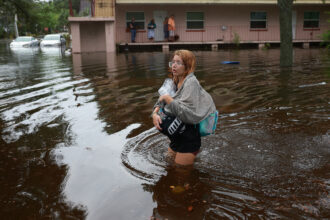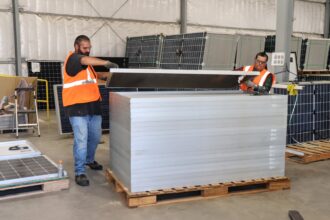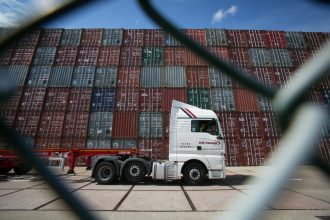SANIBEL, Fla.—Few images of Hurricane Ian’s destruction in Florida a year ago this week were more indelible than those of the swamped causeway here, the only link between the mainland and barrier island where this small beach community is located.
Ian’s high winds and storm surge flattened swaths of southwest Florida, where the hurricane came ashore Sept. 28, 2022 as a category 4 storm packing winds of 150 miles an hour. Its pounding rains left widespread flooding across the state’s interior. In all, Ian was responsible for $113 billion in damage and 156 deaths, making it the costliest hurricane in state history and third-costliest on record in the United States, after Katrina in 2005 and Harvey in 2017.
The scope of the disaster was staggering, but it was the images of the Sanibel Causeway, its three-mile span washed out in five places, that perhaps best encapsulated the might of a storm capable in one fell swoop of leaving an entire community isolated and wounded.

A year later, construction continues on the causeway, as it does in Sanibel.
Every structure here suffered at least some damage, and much of the community remains displaced. Of some 6,500 residents before the hurricane only 1,500 are back in their homes, and of more than 500 businesses 100 are up and running. No condos have reopened, and many of the buildings loom skeletal among the palm trees as the trucks of contractors bustle by on the streets. Mayor Richard Johnson believes it will be years before the community is fully restored.
“We’re a little bit beat up these days,” the mayor said. “Battered but not broken.”

A Horrific Experience
Sanibel shares the name of the 17-square-mile barrier island where it is situated, off the coast of Fort Myers some 150 miles south of Tampa. The island is one of two accessible by the causeway. The other is Captiva, which is smaller and just over a bridge from Sanibel. Ian made landfall just north of here on Cayo Costa, yet another island that is uninhabited aside from a state park.
In Sanibel there are no traffic lights, and a lot of people get around on bicycles. The main thoroughfare is Periwinkle Way, which is lined with shops and restaurants like the Lazy Flamingo (still closed). Well before the storm, local regulations had limited growth and development, enabling the island’s white sandy beaches and natural spaces to shine as primary tourist draws.
Some 70 percent of the land area is protected, most notably by the J.N. Ding Darling National Wildlife Refuge, which is part of the country’s largest ecosystem of mangroves, peculiar trees that appear to float above the waters of the estuarine environments where they flourish as their roots shoot beneath the surface. The refuge is famous for bird-watching and named for the nationally syndicated editorial cartoonist and pioneering conservationist responsible for the Federal Duck Stamp Program, aimed at raising funds for wetlands protection.
Many residents began their lives here as vacationers who, after many returns, eventually never left. Among them is Jim Delaney, who with his wife began visiting as far back as 1981.
Now a widow and retired from a bank in Pittsburgh, Delaney lives in a tidy clapboard home not far from the beach. He loves the sand and waves and getting around on his bike, and he makes a habit of riding everyday up to Doc Ford’s Rum Bar and Grille, named for the protagonist in a series of novels penned by the best-selling author and local fishing guide, Randy Wayne White.
“If I’m not there everyone wonders where I am,” said Delaney, 76. “Sanibel is laid-back, easy-going, family oriented.”
Delaney’s house is on a small hill, and as Ian neared he believed the structure would be high enough and its roof sturdy enough for him to ride out the storm at home with a neighbor.

The men thought the hurricane would veer north and did not anticipate its nine- to 13-foot storm surge here. As Ian came ashore, the house filled with three feet of water, forcing the neighbors to perch on a kitchen island. By nightfall, the deluge outside began to weaken slightly, and with the storm still swirling the men were able to wade in the dark through hip-deep water to another neighbor’s two-story house. Both men were rescued a day or two later, Delaney by helicopter. He describes the experience as horrific and believes the neighbor saved his life.
Over the next few weeks Delaney stayed with family members in Orlando and then Stuart before getting his own apartment in Fort Myers, where he lived for the rest of the year after Ian while his house underwent massive repairs.
With the repairs finally complete, Delaney moved back home less than a month ago. It did not take long for him to resume his daily habit of riding up to Doc Ford’s Rum Bar and Grille.
“It’s good to be home,” he said.
“I Don’t Want Your Trailer, and I Don’t Want Your Loan”
Few people would be more prepared after a hurricane like Ian to navigate the federal disaster relief system than Chauncey Goss.
Goss is chairman of the board for the South Florida Water Management District and son of the former Congressman and CIA Director, Porter Goss, who also was Sanibel’s first mayor. The younger Goss grew up on the island and today lives here with his wife and works as a consultant providing fiscal policy analysis and budget forecasting for firms working with the federal government. They have three grown sons, and at the time of the hurricane two lived with them.
With Ian looming, Goss and the family packed everything they could take with them and headed to Charlotte, N.C., where one of the sons was getting married.
“The wedding was great,” he said. “We just tried to disconnect and honestly not look at our phones.”

Afterward the family rented a U-Haul van and went to several Home Depot stores to load up on generators, chainsaws, bottles of water and personal protective equipment, anything someone might need. Then the family members drove back to Florida. A friend took them by boat to the island. The friend already had sent pictures of their house, so that they could prepare themselves.
“The house had been filled up with water to about shoulder-height,” Goss said. “Pretty much everything was ruined.”
Goss connected with the federal agencies, but when he requested shelter assistance the family was directed first to Alabama and then Brooksville, north of Tampa some 200 miles away.
Instead, Goss was able to move with his wife and one of their sons into a place owned by her family in Vero Beach, a somewhat more convenient 160 miles away north of West Palm Beach. Then the family got to work on clearing debris from the Sanibel property, making the long commute back and forth. Three months later there was enough space in the driveway for a trailer, which made the family happy. The trailer would provide a means of moving back to Sanibel.
Before Thanksgiving the Federal Emergency Management Agency approved the trailer, and Goss hoped to be moved in by Christmas. But the holidays came and went, and the family still was waiting. Eventually the family members were able to get a Sanibel house owned by Goss’ parents repaired to the point where they could move there in January. When FEMA called in March to ask whether they still would want the trailer in April, Goss said no thanks.
“I’ve got a master’s in public policy, and I’ve pretty much spent my entire life with federal agencies,” he said. “I thought I should be able to navigate this, and I really couldn’t.”


Meanwhile, Goss was working with the Small Business Administration toward a loan but found it impossible to meet requirements for documents at a time when his home office was destroyed. At one point he provided pictures of documents only to be told the files needed to be PDFs. Then he was told the documents needed to be scanned. At a disaster center in Sanibel he asked whether employees there could scan the documents for him but was told they could not help.
“What I found the most troubling about the federal response was the false hope that the agencies tend to offer,” said Goss, who testified about the ordeal before the House Oversight and Accountability Subcommittee on Government Operations and the Federal Workforce, which met in August in Fort Myers. “I just said I don’t want your trailer, and I don’t want your loan.”
Recently Goss signed a lease on a Sanibel property where he and his wife plan to live while work continues on their house. Goss hopes the repairs will be done in about six months, and at that point he and his wife plan to sell the house and move someplace else on the island.
“Having lived through that experience, once is pretty much enough,” he said. “We’re looking at buying or building something that’s got a little bit more elevation to it.”
An Existential Threat
At the corner of Periwinkle Way and Tarpon Bay Road there is a bulldozed lot where there once stood a Sanibel landmark, Bailey’s General Store. Since 1899, the family-owned business had been passed down through generations, making it one of the oldest businesses in Florida.
“It’s weird to see how small the property looks without any buildings here or people here,” said Calli Johnson, 32, cupping a hand over her eyes as she surveyed the dusty lot in the late-afternoon sun. “It’s extremely sad for our family, and the community of course.”

Bailey’s General Store sold groceries, hardware and gifts and was the centerpiece of a shopping center, which the family also owned. The shopping center served as a community gathering place with a laundromat, gas station and other establishments offering vacation and bicycle rentals.
Calli Johnson’s great-grandfather on her mother’s side started the general store, and she functioned as the assistant general manager alongside her father, Richard Johnson, who was the general manager and also is the town’s mayor. Her mother oversaw the produce, bakery and deli, her sister the finances and her brother anything that needed fixing, although nobody really had titles and everyone just did what needed to be done. The family also owns The Island Store in Captiva and between the two locations employed some 100 workers at the time of the hurricane.
In Sanibel, the shopping center was swept away by Ian.

The general store flooded with some six feet of water, and the storm also tore off its roof. The rush of water was powerful enough to displace the cash registers and topple the coffee bar. When the family returned to the store after the hurricane the scene was shocking, Calli Johnson said.
“It doesn’t really compute in your brain, to see it from what it was,” she said. “It’s like an alternate universe.”
The shopping center was demolished aside from the historic gas station, which the family plans to preserve. Everything else will be rebuilt, although with some elevation. The Island Store in Captiva is open. Bailey’s General Store is one of thousands of structures here that remain in disrepair, although residents like Calli Johnson feel hopeful.
The Sanibel Causeway reopened a few weeks after Ian with temporary repairs, and permanent fixes are expected to be complete by the end of the year. The struggle continues for businesses, which depend on vacationers, and many of the places where vacationers stay are nowhere near reopening. But the community has celebrated other successes. The post office is open, and so is the school. “I’ve never seen kids so happy to go back to school,” Mayor Richard Johnson said.

Ian will leave Sanibel permanently changed, although Calli Johnson describes the situation as a “reset.” For every resident who has left since the hurricane, more want to move in, she said, drawn by the rare spot of south Florida beach untouched by dense growth and development. The limiting factor will be property insurance, as rates statewide have skyrocketed in recent years.
“Some people would say the vacation opportunities were becoming aged, and so now we have the unfortunate opportunity to freshen things up,” she said.
“Eventually there are going to be major changes in the insurance industry, and that is going to change the type of person who can afford to own here,” she said. “It’s going to be even harder for a young family to live out here.”
Some of the residents have put together a coalition of local organizations aimed at understanding and addressing the existential threat climate change poses for the barrier island. Since March the group has held a series of town hall meetings. The first drew some 600 people and was focused on providing a place where residents could share their personal Ian stories.
Keep Environmental Journalism Alive
ICN provides award-winning climate coverage free of charge and advertising. We rely on donations from readers like you to keep going.
Donate NowLater meetings have included discussions like how to build back in a more resilient way. Other conversations have touched on how to improve the local emergency response system, although the residents have not yet faced more difficult issues, like whether to rebuild in more vulnerable areas, said Bob Moore, a Sanibel resident who helped establish the coalition.
For Calli Johnson the issue is deeply personal.
“Climate change has never been more real to us, and while there are some people who choose to move, it’s not as simple of a solution for a lot of people as it might be for someone who’s looking at this from another part of the country,” she said.
“There are a lot of generational families that live here, and like anyone who has history somewhere it would be hard to abandon that,” she said. “Specifically I have a family legacy to continue, and hopefully I can do that in a way that is responsible.”













